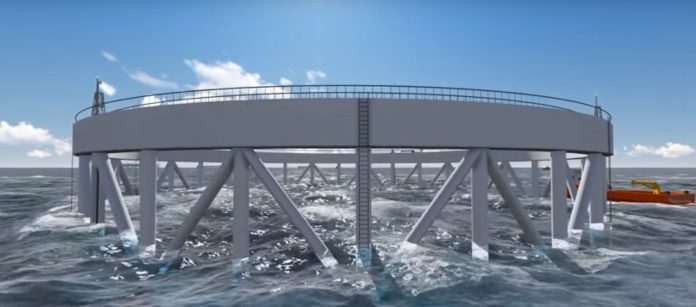NRS wins development permit for the concept, Arctic Offshore Farming, but may have lost a deep-pocketed partner in Aker, as regulators reduce the project’s scale
Norway Royal Salmon and its offshore engineering partner, Aker Solutions, have been granted a coveted development permit of “7.68 development licenses” to bring to life an 5,900-tonne fish-farming concept, albeit in smaller scale.
The Fisheries Directorate, which is a regulatory body led by figures from the industry, allowed the semisubmersible design at the weekend. Already, graphical impressions show large, 77-meter net pens akin to circular offshore oil rigs.
Instead of oil, however, 3,000 fish will fill pens fed and powered remotely, with “morts” sucked away automatically.
“The licenses are a recognition of a long and good development process in which NRS, Aker ASA and Aker Solutions have developed a semi-submersible offshore fish farm designed for harsh areas,” a statement said.
More scale
Offshore fish-farming is seen by many as the answer to gaining scale without growing lease areas, while also keeping effluent dispersed naturally at sea and sea lice away from the rivers, lochs and fjords where young wild salmon swim. Others see offshore farming in more exposed sea areas as pure economies of scale; as just another way to harvest, or as supplementary work for Norway’s work-starved offshore energy supply chain.
NRS said the original concept required four units and 15 licenses, so regulators have watered it down to 7.68 licenses at the mouth of a fjord. The scale-down has cost NRS a partner in Aker Solutions.
“Because the project has been scaled down to about half of the original project size and the capital requirements have been significantly reduced, Aker has chosen not to move further into the pilot and realization phase. Aker Solutions will continue as a technology and collaboration partner in the project,” a statement from NRS said.
Exposure
While more exposed “offshore” — nearshore but less sheltered, really — good water exchange at the site will help fish grow healthier. A first smolt “deposit” is due in the summer of 2020, with a “first-fish” harvest about 15 months later.
“The industrial ambition is to combine knowledge from the fish farming industry with offshore expertise to develop the aquaculture industry of the future and secure sustainable future growth for the Norwegian aquaculture industry,” a statement said.


